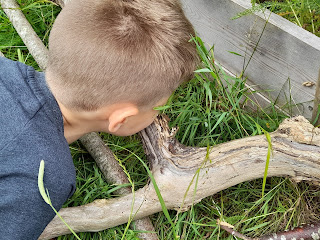Autumn Learning - STEM
Getting Both Outdoor Learning and Forest School ready for the next few months when the days shorten and the weather turns cold is a busy time. Getting the actual spaces ready as well as the activities is a juggle, fitting in the prep and planning around actually taking the children for sessions is almost impossible! A lot of thinking on your feet is required! And involving the children is a given.
The Wildlife Garden is by no means ready but the bare bones of what is needed is in place to build on. This was achieved by two weeks of 3 Forest School sessions a day for four days each week, including all classes from Year 1 to Year 6, and laying the foundations of how the area needs to be looked after. The children also joined in the maintenance and improvements to the area. A sudden 'Indian Summer' sent the temperature up and the sunshine out and the children's enthusiasm blossomed.Obviously, after both a six week Summer break for some, and a 5 month break from school from pre-lockdown for most, this month is a return to school after a very unusual Summer for all. Outdoor Learning has helped the transition back into the school environment, back into learning, and back into enjoying the curriculum.
This week we moved to a different area on Chartham School grounds. Here we have much more scope for den building as well as a huge Mud Kitchen! The children are beginning to see the advantages and differences in the Wildlife Area and here. Neither is better, both offer a range of learning experiences, and some activities will remain the same, and for this fortnight they will get to explore new experiences also.... before we move on to yet another area in our School Grounds!
This basecamp is in a much more physical space. In the Wildlife Garden we are visiting the creatures that live there. There is no space to run and climb, but there is opportunity to bug hunt, pond dip, lizard spot, and make space for the elusive hedgehogs and snakes that visit. You can listen to birds and plant flowers. You can build a den of sticks and enjoy and immerse yourself in nature. It's perfect for natural science links to the curriculum.
With the 'Great Chartham Bake Off' that the children instigated this week, the challenge was to find the right consistency for mud to actually stand as a cake!
Some of these experiences will be the result of collaboration between class teachers and the Forest School Leader, a simple chat can frequently make an outdoor idea a lesson reality. This week Year 3 have been listening to the sounds of birds in the classroom. Each day they're introduced to a different Forest School RSPB soft-toy Bird (photo below), and listen to and compare the song it sings. They have taken the opportunity when outside to use their new knowledge to seek out both birds and song while in the School Grounds. Selecting spaces they felt the birds would be and listening carefully for a bird they could identify.
We were also able to use this experience as an RSPB Wild Challenge.
While Forest School remains a very fluid entity, with minimal planning, following the interests of the children, planned Outdoor Learning will often be fulfilling a key learning intention, usually in a more meaningful and memorable way.
The freedom of following your interest in Forest School leads to all different kinds of discovery that would be difficult to plan. This week two Year 6 boys were fascinated by the microscope attachment to my phone and they delved into looking very closely at the leaves, and rocks, and wood around them.
It's an opportunity any child could take up but would be difficult to do with 30 pupils! Forest School allows for that extension more freely, the opportunity to take an idea and go with it! In this specific case, the chance to see the world in a whole new perspective!

These are the pictures that they took:
One or two other children wanted to see, declared it 'cool', and wandered off! These boys, each from a different class, went off to seek things they wanted to see in more detail, each spent 20 minutes+ twisting and turning their found objects into focus and describing what they could see. This led to speculation of why these things were actually this way in the first place, and a foraging into the information books for answers.
Next week we can build on this, with the same activities because repeating is imprinting, and extending opportunities to go further: More information. Bug boxes to look at minibeasts close up. More magnifiers to help general exploration, maybe a mini outdoor science lab....?
Who knows?
Let's see what another week of Forest School brings!



















Comments
Post a Comment